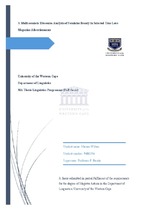| dc.description.abstract | Advertising and media imagery shape attitudes about race and ethnicity, which means that advertising media play an influential part in constructing the frame through which individuals perceive racial differences and negotiate norms and ideas around ethnicity. Physical signifiers such as skin colour and hair are not only considered to be the most important facets in global beauty culture but are also seen as two principal phenotypes for racial classification (Mercer, 1987). These two attributes are also deeply situated within Black Feminist Discourse Studies
and are therefore, culturally and socially significant (Erasmus, 1997; Hunter, 2002). As Dyer (1997:539) states: “every decision about a person’s worth is based on what they look like, what they speak, and where they came from.” Hence, body and hair politics point to power struggles which stem from historical discourses. As part of a capitalist environment, magazines such as True Love are also perceived as cultural commodities which occupy an important role in creating, transmitting and disseminating cultural meaning and in this regard, advertised texts are rich in cultural meaning and embedded with hidden ideologies. As a vehicle of social communication, True Love professes to be a mouth piece and a representative of the liberal, modern Black South African woman and portrays itself as a guiding companion and expert on womanhood (Laden, 2001). In this capacity, the magazine also creates and transmits messages about ideal feminine beauty.
Following a multi-semiotic approach, by incorporating multimodality and social semiotics as proposed by Kress and Van Leeuwen (2006), Van Leeuwen (2006; 2008) and O’Halloran (2011, in press), beauty advertisements are scrutinized in terms of the different semiotic principles which afford for different meaning-making opportunities and interpretation. Critical discourse analysis suggested by Fairclough (1992) and Wodak (1995) renders a supportive function to this social semiotic multimodal framework, in order to critically explore how the notion of ideal feminine beauty is constructed in True Love and to establish how inter-semiotic
relations are created, reinforced and function to sustain hegemonic ideas in present-day beauty advertisements. The findings suggest that socio-cultural meanings attached to phenotypic traits such as skin and hair remain significant in contemporary society as a result of the repeated themes in media, especially advertising. Moreover, the consequential emphasis on beauty culture and the
omnipresence of idealised imagery in mainstream media are responsible for composing and sustaining the belief that Whiteness is the only valid prototype of beauty. The whitewashing of Black models show how idealised preferences in media prevail. Advertisements display how the message of White superiority and supremacy is constructed visually and verbally, ultimately producing an overall ‘visual language of Whiteness’ which leads to devaluing and erasing forms of Black identity, while enhancing forms of White representation. This paper exposes existing dominant cultural narratives in the True Love advertising discourse that simultaneously produce and inflate an idealised Eurocentric version of feminine beauty. The hegemonic standard of feminine beauty dictates that women conform to a specific ideal which involves engaging in practices such as skin lightening, hair straightening or wearing weaves. This dissertation concludes that digital alteration techniques and photographic manipulation are predominantly used in mass media to portray advertised images resembling ideals closer, which means that it effectively enhances rather than detracts from the norm. Thus, White women look Whiter, thinner, richer and blonder. Caucasian models in advertised texts all have light hair and are seldom portrayed with dark hair. Light-skinned Black women portray Western mediated standards through physical appearances which seem to emulate those of their White counterparts, which Hunter (2011) describes as the ‘illusion of inclusion’. Although this marketing strategy operates under the premise of fostering ethnic diversity and to include women from all racial backgrounds, it reinforces the belief that Anglo-Saxon beauty norms are the only valorised signifiers of idealised beauty. Essentially, having a light skin colour is associated with sophistication, social mobility, success and the resulting financial and economic well-being. Based on this, the magazine appears to promote and celebrate feminine
beauty based on a Eurocentric ideal. | en_US |

